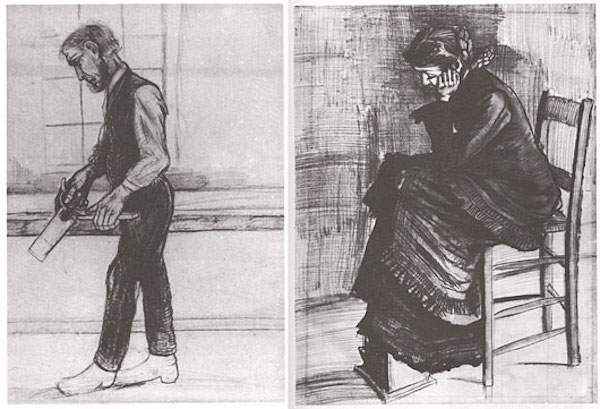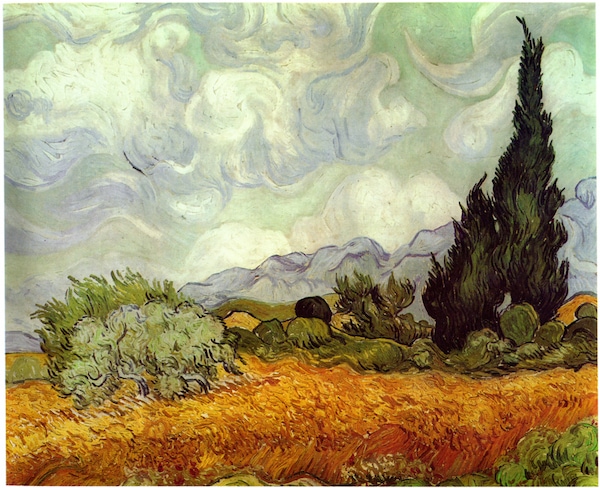TODAY I’m going to improve your soloing.
Plain and simple. In the next 10 minutes.
You’re going to find out if you can play a good idea.
You’ll also see if your ideas are rubbish.
There will be NO opportunity to hide behind scales, hip lines, circle picking, negative harmony, or any of the other rabbit holes that’ll make you avoid, you know..
[thrive_2step id=’13449′]** be sure to check out the bonus where I show you the exact exercise I use to work on this. [It’s easy and it really will help you play better] **[/thrive_2step]
First, look at these Van Gogh sketches:

You can see in the first one that he’s struggling with proportions. Look at the carpenter’s HUGE hands and weird head. The second one is from two years later.
It’s a bit better, isn’t it?
So –
Van Gogh was rubbish.
Van Gogh did a lot of practice.
Van Gogh got good.
Remember this! – Once upon a time, Van Gogh wasn’t that good and had to do tons of work. He had to do hundreds of shit drawings until he figured out how to do hands.
Ok great. But I’m a nerd. I want to know…
 How?
How?
Exactly HOW did he go from drawing weird out-of-whack heads to capturing the light brushing the folds of the skirt?
Wouldn’t it be fun to ask him questions such as:
- How did you work on proportions?
- When you look at that early drawing, how would you see it differently now?
- How did you work on this?
- Where was your attention?
- Here’s a drawing I did – how can I make it better?
Comparing before and after examples like this shows the development.
You can see the work.
And if you can figure out the work then you can do the same.
Before & After
One of the ways I can show you the work, and help you with your guitar playing, is to take some before and after examples that demonstrate the transition from ‘D’oh!‘ to ‘Excellent, Smithers!‘
And the best way I can do that is to show you one of my earlier efforts that I’d rather nobody ever heard again. And one that I think sounds better.
Ok, so here’s the first one from a million years ago [Please don’t tell anyone else you’ve heard this! It’s just between you and me, OK?]:
Clip #1 – before
I want you to notice my ‘proportional struggles’ – in particular, the time-feel and the flow of ideas. In this clip, my playing is NOT in time. I’m nowhere near the beat and the ideas don’t connect up. It feels to me like someone reading random sentences from a book.
As a listener, you get that kind of ‘nothing-y’ feeling because there’s no story or development of the ideas. It doesn’t go anywhere.
In the second example, my ideas have more flow. My time-feel is better. There’s a sense of development.
There’s a difference between the two clips.
Clip #2 – after
So What’s The Difference?
Now look, there are MANY things in the first clip that I can see to improve [and the second for that matter].
But when I look at that playing in the first clip, I know that what’s going wrong is not thing like, ‘I need to learn more language’, ‘I need to work on rhythmic permutations’, ‘I need to play more’, ‘I need to be more accurate with the note choices’, or any of the many things that I’m struggling with there.
The biggest thing I’m missing – the glaring most giant thing that I would tell young Mike in the first clip – is:
You’re not playing CLEAR IDEAS
And this compounds into every other area of my playing. There’s a lack of control over the ideas. It seems difficult to grab onto exactly where my phrases start and end. It’s especially obvious if you listen to how I end phrases. They don’t really end – they sort of peter out into nothingness.
How Does Playing Clear Ideas Help?
When you play clear ideas, it’s much much much much MUCH easier to develop a solo that tells a story. Check this out:
- Without the clarity, it’s like readingwithnospacesorpunctuationatallyou
canttellwhereoneideabeginsandoneends :) - Or maybe it’s like the ideas have no relation potato flower day full pea.
- Or maybe it’s like trying to express ideasy but theere is exxtra unwanted informationing that obscuress the idearly.
When you play clear ideas, you can see your complete idea and then DO SOMETHING with it.
Also, because you’re not scrabbling about, it’s easier to HEAR everything else around you. And when you can hear deeper you can get more connected to the band, the rhythm, the feel. Because of that, you can relax and let your ideas unfold. You can let things take their time.
And that’s how you can get that kind of easy flow.
Ok, I’d like to show you how to work on this.
How Do I Know If My Idea Is Any Good?
To help you play better solos, here’s the exact exercise I used to make that transformation from the first clip to the second.
It’s an exercise that’ll make sure your idea is a good one.
A Strong one!
Stronger than whack around the chops from Mr Shatner.
[thrive_2step id=’13449′]
